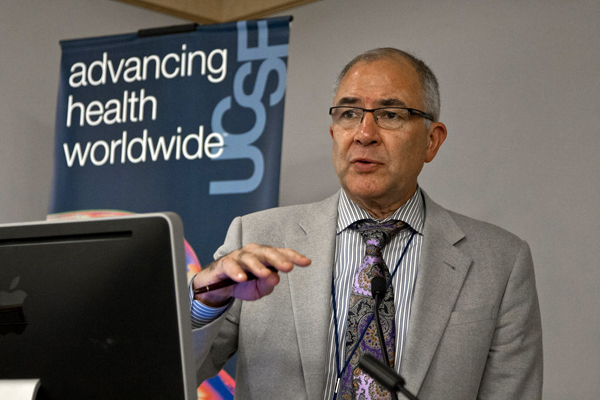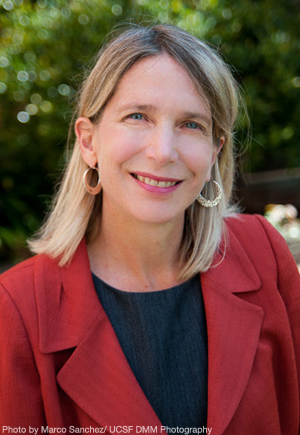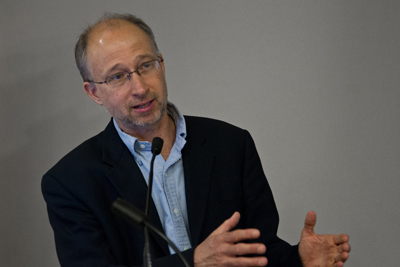AIDS/HIV Briefing at UCSF Highlights International AIDS Conference Agenda

Paul Volberding, MD, director of the UCSF AIDS Research Institute, gives an overview of the epidemic during a recent news briefing at UCSF held in advance of the XIX International AIDS Conference in Washington, D.C., this month.
FOCUS ON:
- AIDS 2012 Declaration Draws Support to End Global AIDS Epidemic
- Early Treatment May Improve Socioeconomic Conditions for People in Rural Sub-Saharan Africa With HIV
- Warner Greene Authors HIV/AIDS Medicine Textbook for Developing World
- HIV/AIDS Prevention with Truvada: How Pregnant Women and Others May Benefit
- AIDS 2012 Conference Co-Chair Diane Havlir Talks About What it Takes to Turn Tide on Disease
- Experts Outline Steps Towards an AIDS-free Generation
- HIV Research: A Long View on a Small Virus
- UCSF Leaders Play Key Role in “DC Declaration” to End Global AIDS Epidemic
- AIDS/HIV Briefing at UCSF Highlights International AIDS Conference Agenda
- UCSF Launches AIDS Blog
The first U.S. meeting of the International AIDS Conference in more than two decades will be held later this month in Washington, DC, and Bay Area reporters got a preview of the new findings that UCSF researchers will present.
Those in attendance at a UCSF news conference on July 2 heard from researchers who have been working locally and abroad on new ways to treat and care for people with HIV/AIDS. Speakers discussed prospects for a cure, strategies for fighting tuberculosis and HIV in patients infected with both, and innovative ways to monitor treatment compliance.
Paul Volberding, MD, director of the AIDS Research Institute at UCSF, has been battling AIDS since the disease was first described in 1981. He noted that the upcoming international meeting from July 22 through 27 will be the first held inside the United States since 1990. That’s because a 1993 ban by the U.S Congress on travel and immigration into the U.S. by HIV-positive individuals was not lifted until January 2010. During the ban, meeting organizers decided not to plan any major U.S. meetings.
When the last U.S. conference convened in 1990 in San Francisco, hopes were dim, Volberding said. HIV infection was still regarded as a death sentence, and combination drug therapies had yet to appear. “It’s obviously a completely different world now,” he said.
According to Diane Havlir, MD, co-chair of the international conference and chief of the UCSF Division of HIV/AIDS at San Francisco General Hospital and Trauma Center, “The San Francisco community has been at the leading edge for responding to the AIDS epidemic ever since it has been recognized.”
Conference Signifies Turning Point in AIDS Epidemic
The upcoming conference signifies a turning point in the course of the epidemic, Havlir said. “For the first time we are going to be talking about the beginning of the end of the AIDS epidemic. …[more than] 25 million people have died from this disease, and now we are talking about ending it.”

Diane Havlir, MD
“There are a series of breakthroughs over the past three years that have put us in this frame of mind,” she said.
Researchers have determined that AIDS drug cocktails taken by those who are infected are effective in preventing transmission to uninfected sex partners. Furthermore, those who are infected appear to fare better when they begin taking antiretroviral therapy early on, rather than waiting until symptoms appear or until CD4 blood cell counts drop. Researchers also have found that adult male circumcision cuts HIV transmission rates in half.
In addition, research in recent years has raised hopes for a cure for HIV/AIDS. In the Feb. 12, 2009 the New England Journal of Medicine, researchers reported that the HIV virus was apparently eliminated and remained undetectable without additional antiretroviral treatment in the “Berlin patient,” Timothy Ray Brown, as the result of a bone marrow stem cell transplant. This outcome has spurred researchers to try to better understand how the treatment worked and to come up with related strategies that might prove effective in helping patients rid themselves of the virus.
Despite progress, HIV infection remains a major problem in the U.S., Havlir said, even if many people no longer recognize AIDS as an important health issue. Although AIDS incidence peaked a decade ago and deaths due to the disease are decreasing, there has been no decline in new HIV infections over the past decade — 50,000 during the past year, she said.
If money is made available, it might be possible to stop the spread of HIV within a few decades, Havlir said. But the opportunity to defeat HIV could be lost if resources dedicated to preventing, diagnosing and treating the disease are not forthcoming soon, she added.
A cure for HIV infection was the subject most on the mind of Steven Deeks, MD, professor of medicine at the UCSF Division of HIV/AIDS at San Francisco General Hospital and Trauma Center and co-chair of the International AIDS Society’s ‘Towards a Cure’ International Scientific Working Group.

Steven Deeks, MD, talks about his work at the news briefing at UCSF.
The goal now is to prevent transmission, to cure people or to do both, Deeks said. “Antiviral drugs suppress the virus but do not eliminate it, so people must take them for decades. … The field needs fresh thinking.”
Deeks has been monitoring Brown through an ongoing clinical cohort study and is conducting additional research related to the search for a cure.
In Washington Deeks will co-chair a session on potential cures, which will cover updates on stem cell transplants, gene therapy approaches that now are undergoing clinical evaluation, discoveries of biological mechanisms that allow the virus to persist within patients, and new drugs in the pipeline.
Photo of Diane Havlir by Marco Sanchez/ UCSF DMM Photography, other photos by Susan Merrell

